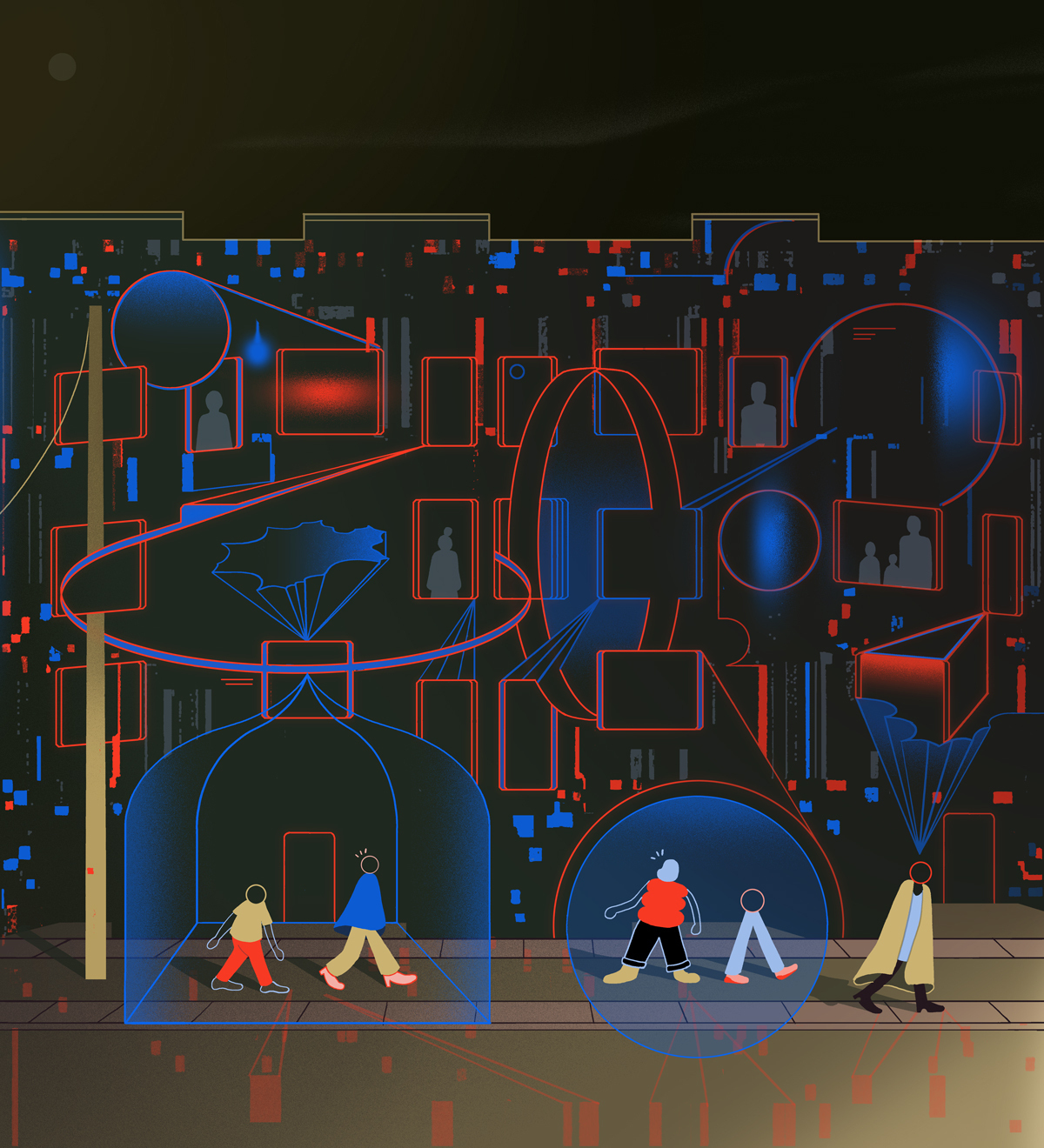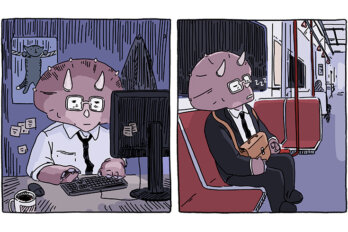If one thing could turn me into a full-blown Marxist, it would be riding the Queen streetcar through South Riverdale. As the tram makes its way across the east Toronto neighbourhood, passing tony furniture stores, jewellery boutiques, and restaurants with $30 mains, I always share the streetcar with at least one or two people who seem to be struggling—with mental illness, with addiction, or just with the abrasions inflicted by poverty.
Listen to an audio version of this story
For more audio from The Walrus, subscribe to AMI-audio podcasts on iTunes.
These are the contradictions of Leslieville, the neighbourhood I called home for over two years. Despite a wave of gentrification and a parade of million-dollar house listings, the area, once known for its working class roots, still has one of the city core’s higher crime rates. Nevertheless, change has been creeping through its streets. Take the Maple Leaf Tavern, a 106-year-old restaurant once known as the “kick and stab,” now a high-end gastropub that anchors the neighbourhood’s northern edge. But, for all the area’s pretentions of being a trendy place for wealthy new families, the men’s shelters and retirement homes haven’t yet decided to up and disappear.
Such contrasts produce real conflicts. In few places is this more conspicuous than the local Leslieville Facebook groups, where residents congregate and chat.
These spaces were a lifeline when I first arrived. My new neighbourhood’s secrets—its best Americano, the ideal bar to read a book in late at night, the perfect breakfast sandwich for a winter morning—were eluding me. Then a friend recommended the Facebook group “I am a Leslievillian!” and I was able to discover all the gems that my regular walks wouldn’t have revealed. Among its members, with all their tips and recommendations, I even found something akin to neighbourliness.
But, beyond the discussions of new restaurants and traffic annoyances, there was another, more discomforting side to the group: all the discussions around people deemed suspicious.
A common sight on the feed are the porch pirates—people who steal packages. As more and more people shop online, it has become common to see posts that not only bemoan the loss of purchases but also include photos or videos of the alleged culprits.
There is an ongoing fight here, ubiquitous in most cities, between the haves and the have-nots. Over the past year and a half, as more people stayed home and craved outdoor time and as homeless encampments grew around the city, that tension has only grown.
Such conflicts are born of borders, and in the twenty-first century, these lines aren’t only legal or even metaphorical. They are barriers policed by technology—by a growing array of cameras, by an explosion of online groups where people of a certain class warn of the presence of another. All of it seems to run on an undercurrent, a simple but difficult question: To whom do our neighbourhoods belong?
The idea of homeowners safeguarding their property seems innocuous. When I had a delivery of wine stolen last year, my thoughts immediately jumped to installing a camera. But, the more I considered it, the more uneasy I became: Even if I could somehow catch an image of the thief, what then? Stalk the neighbourhood looking for both the culprit and a fight? There is something absurd about the idea that an invader of Leslieville like me might suddenly become outraged by the loss of a trio of bottles I couldn’t really afford, but could also afford to lose, while every day near my home I see people who don’t have the luxury of either my ill-considered indulgences or my indignation.
The shift to surveillance technology has arrived not only as a response to lost Amazon packages but through companies like Amazon itself—and whether this is actually ironic depends on just how insidious you believe these businesses to be. In 2018, Amazon acquired Ring, a maker of smart-home technology that includes doorbells featuring built-in cameras and microphones. The idea is for you to be able to see that your friend Nitesh or Jane is at the door when the bell rings, but it has also created the ability to track those deemed unwanted—not just on one’s own porch but also on the street that falls in the camera’s field of view.
The technology, which has proliferated in the past few years, has found its natural home among the neighbourhood groups popping up on Facebook and community-oriented apps like Nextdoor. The conceit seems to be that, if a camera is present, one is at least doing something. Better to have this technology as part deterrent, part solution to thefts than to have one’s packages lifted without proof—as if you were some kind of sucker. Online, the last thing anyone wants to be is a sucker.
Whether these products achieve that aim is much less certain. What seems more likely than these cameras leading to some semblance of justice is people posting these videos for the same reason we might relate the story of a lost package to a friend: to be heard, to achieve a sense of catharsis.
There is, however, another option, which an increasing number of Ring users are turning to: passing on the footage to the police in the hope that the authorities will do something. By 2019, over 400 US police forces had partnered with Ring to gather footage; users who opted in became part of a vast new CCTV array. While this kind of arrangement hasn’t yet extended through Canada to the same degree, the phenomenon speaks not so much to the spirit of neighbourhood watch as to the logic of our modern era. Cameras are everywhere, and those with the means to own both the technology and the homes over which it watches can then surveil anyone, carollers and homeless people alike.
The interrelation of surveillance, technology, and justice is an issue that Chris Gilliard spends a great deal of time thinking about. By day, Gilliard is a visiting research fellow at Harvard University’s Shorenstein Center on Media, Politics and Public Policy. On Twitter, under the handle @hypervisible, he criticizes the surveillance of tech companies.
When I told him about my little wine adventure and my subsequent impulse to buy a Ring, Gilliard laughed. He then offered his own story about having his car egged outside his Michigan home and the neighbour who offered to pass along Ring footage for the police.
“It’s my pretty firm belief,” says Gilliard, “that the police should not be called unless someone’s life is in danger.”
That can seem, to some, like a noble if naive thought. Yet Gilliard offers a retort. “The likelihood that it was a Brown or Black person who egged my car, based on where I live, is pretty high,” he says. “When you call the police on a Black or Brown person, there’s a good chance you are putting their life in danger. I don’t think that is a thing one should do lightly.”
Part of what is discomforting about surveillance technology is its easy imbrication with the potential excesses of police action. Another part is the normalization of surveillance itself. “I don’t want to sound too conspiratorial,” says Gilliard, “but having something stolen off your porch and saying, ‘I should get a Ring’ is what Amazon wants you to do.”
And, indeed, this idea seems far from conspiratorial. Amazon has gone out of its way to present itself as a defender of homeowners everywhere. In the recent announcement for its Ring Always Home drone—literally a small aircraft that flies about your house—the promotional video showed a would-be burglar scared off by the buzzing creature that rushed to the window.
According to Gilliard, that’s not all. “For one, getting a Ring lets Amazon off the hook because they don’t have to replace a package,” he says. “But it’s also a handy way for them to surveil their workforce.”
The use of surveillance tech normalizes the idea that the world should be a place in which neighbourhoods are fortresses, with underpaid workers delivering goods to the relatively wealthy under an unblinking eye.
The question at the root of the issue is: Who watches and who is watched? Inevitably, in a place like Leslieville, those who for whatever reason end up stealing packages are very likely not rushing back to minimalist semidetached homes. Just as the trouble with calling the cops is the disproportionate rates at which marginalized people are harassed and even brutalized by the police, the use of surveillance technology entrenches the increasingly hard line between the haves and the have-nots. After all, you need a porch on which to mount a Ring camera in the first place. In a country undergoing a profound housing crisis, that alone is no small thing.
If posting footage of one’s pilfered delivery doesn’t actually have the power to prevent theft, perhaps the rationale of the neighbourhood Facebook group lies more in its delineation between us and them. At their core, online groups represent communities coming together to defend their own interests—not just from porch pirates but from developers, cities, or even those bars or restaurants daring to do wild things like open a patio.
Whose interests are actually served, however, is a matter of debate. While what is currently exciting the Leslieville group is whether transit should run above or below ground, across the city, social media groups have become a way for people to defend their idea of who should be allowed to join the neighbourhood. Consider the fight over a homeless shelter in Toronto’s trendy Yonge and Eglinton area. The story sounds almost too on the nose: in response to the pandemic, the city leased an aging apartment building to allow unhoused people to live in safer, socially distanced spaces. Locals were furious. Some alleged that the shelters led to an uptick in crime, and after a city worker was stabbed—and a resident of the shelter was charged—tensions only grew.
On the resulting Facebook group, “Community Safety-Midtown Toronto,” residents collectively gathered to resist the shelters and marshal their response to city councillors and others in power. One need only try to join the group to get a sense of its true purpose: you are asked whether you believe the area is now more dangerous than it used to be, you are asked whether you agree that supervised injection sites keep people with addictions marginalized, and you must agree not to share screenshots with outsiders.
It is hardly unique. In New York, an Upper West Side neighbourhood—wealthy, white, ostensibly liberal—banded together in a Facebook group called “Upper West Siders for Safer Streets” (now known as “Upper West Side Together”). Its goal? To push out a homeless shelter. The organizing, though it began online, morphed into an ad hoc residents’ association, which even hired a lawyer who threatened to sue the city.
This is what the combination of money and social media savviness can do. In that sense, the online neighbourhood group is akin to a gated community within a community: an enclave for those with the time, means, and know-how to keep an area pure. There is an obvious logic to it. If you cannot put up literal gates, put up virtual ones.
The difficulty with technology is that it is almost impossible to opt out once it has arrived.
Technology moves in a particular direction, buoyed by the currents of capital. Facebook groups cement neighbourhood divisions; Amazon turns porches into panopticons; credit assessments and job applications are sorted by inscrutable algorithms—and it amounts to more data for those in power, be they police or politicians. It all happens almost imperceptibly. At the start of 2021, Amazon announced it would be adding cameras to its delivery vehicles—ostensibly to ensure driver safety, but come on.
That is the thing about Facebook or Ring or any sort of new technology: once it exists, its particular affordances will beckon people to use it in particular ways. The feeling of powerlessness that comes from missing mail now has an outlet, a response. What was once impossible to address now has a structure and an incentive: comments from fellow neighbours bemoaning the riff-raff or encouraging vigilantism, a platform that nudges the most inflammatory posts to the top.
Last year, Facebook announced it was testing a hyperlocal Neighborhoods feature, formalizing—maybe entrenching—what was thus far impromptu and user driven. The location of its pilot program? Canada, whose highly online, highly affluent communities form the most profitable market outside the US and thus are the perfect test bed.
The difficulty with technology is that it is almost impossible to opt out once it has arrived. In instituting the logic of surveillance, Big Tech offers a compelling proposition: protect yourself by gathering with the like-minded. You ride a streetcar through a city and brush up against people of all types. But, when you arrive home, you can log on to a social network and warn others like you about signs of abnormality, crime, and misdeeds. All you need is a comfortable salary, a house with a porch, and a doorbell with a little camera hidden inside. It might not have been your neighbourhood before, but you have the power to defend it, to make it yours, to make sure it stays yours.




